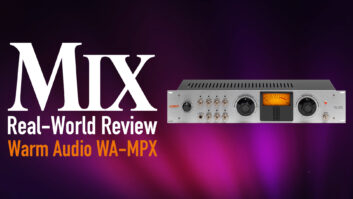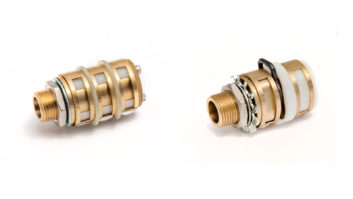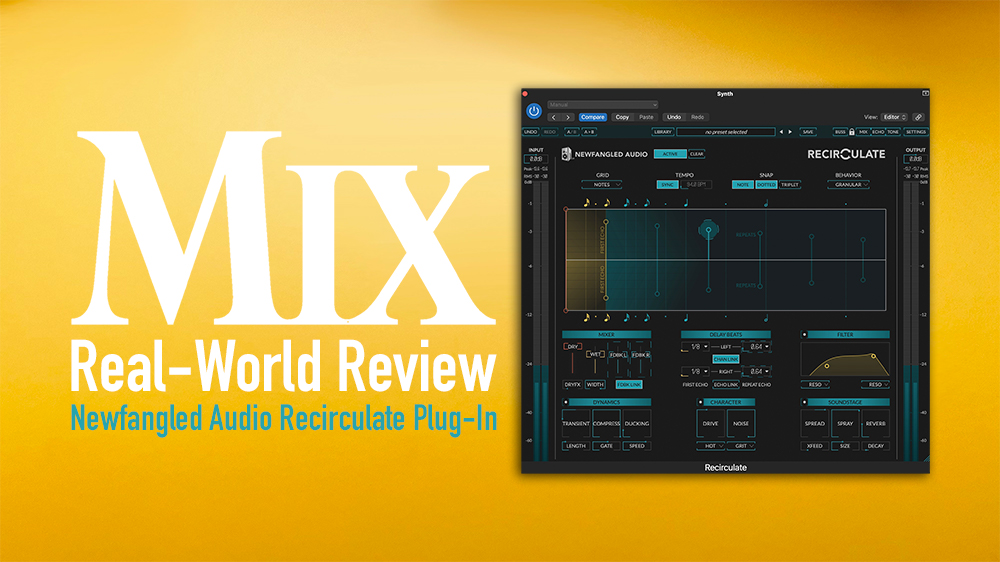
| MIX VERDICT: NEWFANGLED AUDIO RECIRCULATE |
| THE TAKEAWAY: “ If you want more than just the basics from a delay plug-in, Recirculate is a powerful tool.” |
| COMPANY: Newfangled Audio (distributed by Eventide) • www.newfangledaudio.com PRICE: $99 PROS: • Facilitates creative delay settings. • Four distinct delay Behaviors. • The First Echo and Repeats can have different settings. • Grid offers control and helpful visualization. • Ducker and Gate. • Six flavors of distortion Filter allows for frequency adjustments and resonant effects. |
New York, NY (April 25, 2024)—Newfangled Audio makes powerful and unique plug-ins, including equalizers, compressors, saturators, transient shapers and more, and the products have active-sounding names such as Punctuate, EQuivocate, Saturate and Elevate.
The company’s latest release is Recirculate (Mac/Windows), a digital delay plug-in that offers exceptional sound-shaping and control features. It lets you apply dynamic effects, distortion, noise, filtering, chorus and reverb to the delayed signal, while you can even use its effects to process the dry signal, which I’ll explain later.
Recirculate is not designed to emulate specific vintage hardware units, though it has sound-shaping features that can add analog-like characteristics to the delayed signal. First and foremost, Recirculate was designed to be a delay that provides maximum control and excellent sound quality.
The interface features a dark, modern-looking design consistent with other Newfangled Audio plug-ins. The GUI is relatively large, and you can resize it up or down. If you want a different color scheme than the default, two alternate options are available in Settings.
The plug-in includes mono, mono-to-stereo, dual mono and stereo configurations, and all the delay controls reside in a single window. A drop-down near the top allows access to a substantial set of factory presets, including many from pro engineers and producers.
For observing levels, the plug-in features tall Input and Output meters on the extreme left and right, respectively, each with adjustable gain. I found the gain controls helpful for adjusting levels coming into the plug-in or going out. The Output control is particularly useful for reducing increased gain from the built-in effects.
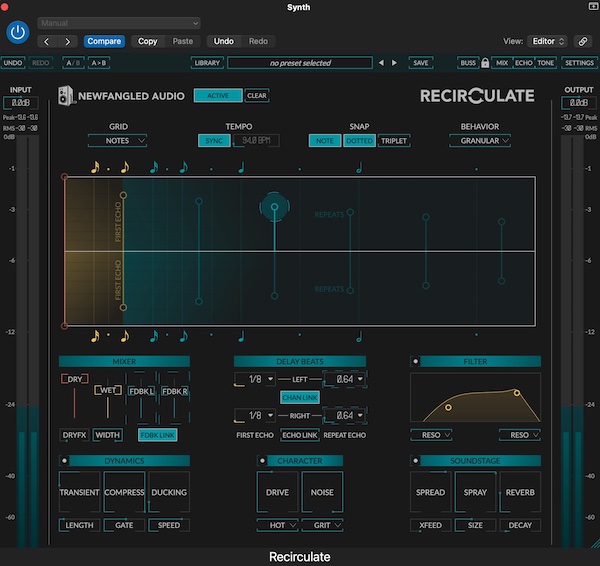
IN GRID WE TRUST
A large window called the Grid dominates the middle of Recirculate’s GUI. It represents a timeline for the delay that can be adjusted by dragging stems left to right. The stems also have circular control points on the ends that you can drag up and down to change wet/dry or feedback levels, depending on the stem type.
The Dry signal is color-coded orange and is fixed in time on the far left. Because it represents the initial signal, it can’t be moved, but you can adjust its level relative to the Wet level. A yellow stem represents the initial tap, which Newfangled Audio calls The First Echo. It can be adjusted closer or further from the Dry signal. Feedback taps after the First Echo are blue and called Repeats.
You can set the timeline to display Notes (rhythmic values), Steps (from 1 to 16) or Milliseconds. The top half of the grid represents the left channel, and the lower half the right. The two can be locked together or set independently. In a mono instance of Recirculate, the Grid still has a right and left side and the same settings flexibility, but it ends up in a mono signal. One of the features that sets Recirculate apart from most other delays is the ability to configure the parameters for the First Echo and the Repeats separately.
The Grid also lets you turn on snapping to make it easy to drag the stems to specific rhythmic values or steps. You can set the Snap to fundamental rhythmic values (half-note, quarter-note, eighth-note, etc.) and dotted and triplet variations. With Snap turned on, when you drag a stem over a beat subdivision, it clicks into place. You can Snap to the Step boundaries if you have set the Grid to Steps mode. If you prefer to adjust your delay parameters with pull-down menus and buttons, use the Mixer and Delay Beats/ Delay Time sections below the Grid. When you make adjustments there, you’ll see them reflected in real-time in the Grid, and vice versa.
The Mixer offers two potent parameters that you can’t adjust from the Grid. The first is the Width control, which changes the stereo width of the delayed signal. The second, Dry FX, is one of Recirculate’s most powerful features. When you turn it up from its default at 0 percent, you add any effects that you’ve turned on to the dry signal. If you set it to 100 percent, the effects will get equally applied to the dry source and the echoes.
MODES AND DYNAMICS
You can change the character of the delayed signal significantly depending on which of the four modes chosen under the Behavior menu. Standard provides straight-ahead performance; no artifacts are added when the delay time changes. Pitch Warp mode bends the pitch of the taps, giving them a warbly sound. They can be made even more extreme using the built-in Modulation effect.
Granular mode makes the delayed signal sound like it’s sliced up. You can adjust it from the Soundstage section with Spray and Size controls, which affect how large the grains are and the amount of randomization. The final mode is Ping Pong, which makes the delay taps alternate from one side to the other. Two controls in the Soundstage section, Mod and Pingpan, are available in Ping Pong, with Mod adding delay modulation and Pingpan determining the stereo placement of the first repeat tap.
Being able to create complex rhythmic delays is only one of the powerful aspects of Recirculate.
Its effects lineup is impressively well-stocked, offering four different modular sections, with several effects in each.
The Dynamics section offers several different processors that allow you to manipulate the audio. The Transient knob works like a conventional transient shaper: Positive values emphasize the transients, and negative values de-emphasize them. The Length knob adjusts how much of the transient will be able to pass.
The Compressor is a one-knob processor that Newfangled suggests using to add density to the delayed signal. It’s primarily meant for smoothing out the taps, but if you turn the Dry FX up, you’ll also be compressing the non-delayed signal.
Both a Gate and a Ducker are available. The Ducker reduces or completely mutes the delayed signal when the dry signal is present and releases when it’s not. It’s great for accentuating vocals and other melodic sources in a mix so that they poke through between the delay taps.
The Gate gives the opposite effect. It opens when dry signal is present and closes when it’s not, so you’ll only hear the delay when it appears simultaneous with the dry signal, but not between notes or beats. For example, you could set up a doubling effect by turning the Gate to about 50 percent, adjusting the delay time to a short value like 5 ms, and turning off the feedback.
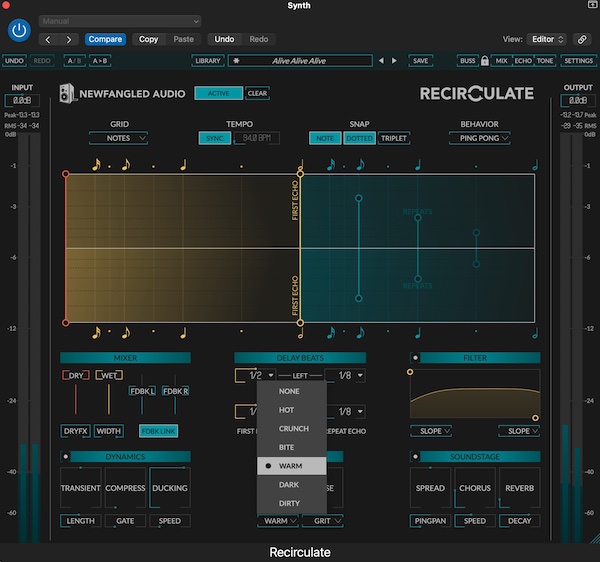
CHARACTER AND SOUNDSTAGE
An effects module named Character has two components: Drive and Noise. Drive offers six distinct flavors of distortion that you can add to the signal using a knob that ranges from 0 to 30 dB. Depending on the Drive type, you can add tape-like, fuzzy, crunchy or complex distortion. They all sound good.
The Noise effect lets you add one of four different noise types to the signal. Of the four noise types, Grit, Grime and Bit are program dependent. That is, you only hear them when there is signal present. The other, Hiss, is a steady sound that can be heard without any source signal hitting the input. It’s useful for tape emulations, in particular. You can have a lot or a little noise in the signal based on the percentage you set.
The Filter section contains low- and highpass filters, allowing frequency control and resonant filter effects. You drag around a pair of control points to change the filter shape. The initial shape depends on your selections for the low and high filter modes: Slope, Reso, Notch, Combo or Scoop.
Brainworx bx_enhancer — A Mix Real-World Review
Having some EQ control over the delayed signal is helpful for making the delayed signal sound significantly different than the dry. You can also use the Filters to create resonant effects.
The final module is called Soundstage. It offers multiple effects, which change depending on the selected Behavior mode. The only effect that’s constant in all four modes is Reverb, which has a single adjustable parameter: Decay (time).
DELAY POWERHOUSE
After using Recirculate for a couple of weeks, it’s become one of my “go-to” delay plug-ins for mixing. Its arsenal of effects and other handy features facilitate creativity in my delay settings. The option to add the effects to the dry signal is a big bonus. The plug-in is well-designed and intuitive. The Grid, in particular, is quite helpful for visualizing and, therefore, better understanding how your settings affect the signal over time. If you want more than just the basics from a delay plug-in, Recirculate is a powerful tool.





